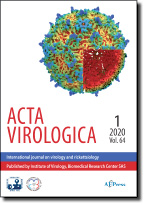Acta Virologica Vol.54, No.4, p.231-245, 2010
|
| Title: Toll-like receptors in immune response to the viral infections |
| Author: I. MIKULA_Jr., S. PASTOREKOVÁ, I. MIKULA_Sr. |
|
Abstract: Toll-like receptors (TLRs) are members of the innate immunity system. They are responsible for the recognition of various antigens and take part in the modulation of immunity responses. In general, they are divided into “bacterial” and “viral” TLRs, even though this classification overlaps in some cases. Genetic similarity of TLRs gives them the status of highly conservative proteins throughout the animal kingdom. However, there is a certain level of variation between different species that can result in semi-disparate recognition ability. Furthermore, their universal signaling pathways predispose them not only as a target for vaccination trials in humans, but also for the genetic selection in veterinary medicine. Moreover, the selection pressure and their conservative properties make them a suitable system for the evolutionary studies, since each separate genetic system has its own unique ortholog/paralog. TLRs 2, 3, 4, 7, 8, and 9 play a crucial role in the recognition and modulation of the innate immunity in response to the viral infection due to their predominant localization on the white blood cells and endothelial cells, while intracellularly localized TLRs lead the way.
|
|
| Keywords: TLR; virus; mutation; diversity; immunity; substitution |
|
|
|
| Year: 2010, Volume: 54, Issue: 4 |
Page From: 231, Page To: 245 |
doi:10.4149/av_2010_04_231
|
Price:
36.00 €
|
|
|
|
|
|
|
|

